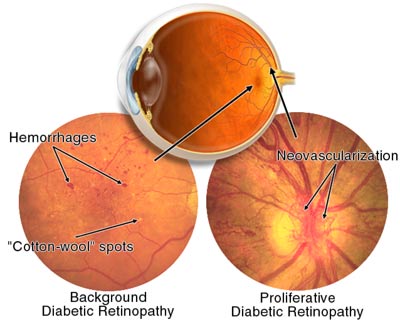Eyesight Risk for Diabetic Patients
There are 23.6 million children and adults in the United States who have diabetes. Diabetes is a diseas in which the body does not produce or properly use insulin. There are two types of diabetes; Type 1- is when the body fails to produce insulin, the hormone that allows cells to turn suage and starch to energy. Type 2- is when the body is resistant or fails to peoperly use the insulin, this is the most common form.
 Diabtetes Effects Vision
Diabtetes Effects Vision
Nealy 80% of all patients who have had diabetes for 10 years or longer may suffer from complications of diabetes mellitus or damage to the retina; also called diabetic retinopathy. Diabetic retinopathy is damage to the blood vessels in the eye caused by diabetes. It is the leading cause of visual loss among American adults aged 20 to 65. Research has indicated at least 90% of new diabetic related cases could be avoided with proper and vigilant treatment and mointoring of the eyes.
Symptoms of Diabetic Retinopathy
There generally are no early warning signs or pain associated with diabetic retinopathy. Characteristic signs of retinal changes may be seen during examination of the retina. Severe retinopathy may develop prior to noticeable vision loss, with late sudden onset of vision loss with hemorrhage or retinal detachment.
With the symptoms of proliferative retinopathy, if bleeding occurs at first, you will see a few specks of blood, or spots, "floating" in your vision. If spots occur, see your eye care professional as soon as possible. You may need treatment before more serious bleeding occurs. Hemorrhages tend to happen more than once, often during sleep.
Sometimes, without treatment, the spots clear, and you will see well. However, bleeding can reoccur and cause severely blurred vision. You need to be examined by your eye care professional at the first sign of blurred vision, before more bleeding occurs.
If left untreated, proliferative retinopathy can cause severe vision loss and even blindness. Also, the earlier you receive treatment, the more likely treatment will be effective.
Cause and Risk of Vision Damage
Approximately 40 percent of all people with diabetes have at least mild diabetic retinopathy affects both Type 1 and Type 2 diabetics. Diabetic retinopathy is a major cause of blindness and tends to be particularly severe in Type-1 diabetes. In general, the longer one has had diabetes, the greater are one's chances of developing diabetic retinopathy. Diabetic retinopathy generally takes at least eight years to develop in juvenile onset diabetes, but may be present at the time adult onset diabetes is first diagnosed. High blood pressure and high cholesterol in the blood are additional risk factors that your doctor will address.
Diagnosis
Because diabetic retinopathy can begin and get a foothold before it causes symptoms, all patients with diabetes should have an eye examination with pupils dilated at least once a year. Often your doctor will take photographs of your retinas. A dye, called fluorescein, may be injected in the blood stream to show further details of the circulation in the retina. This is called fluorescein angiography.
Diabetic retinopathy has four stages:
1. Mild Nonproliferative Retinopathy. At this earliest stage, microaneurysms occur. They are small areas of balloon-like swelling in the retina's tiny blood vessels.
2. Moderate Nonproliferative Retinopathy. As the disease progresses, some blood vessels that nourish the retina are blocked.
3. Severe Nonproliferative Retinopathy. Many more blood vessels are blocked, depriving several areas of the retina with their blood supply. These areas of the retina send signals to the body to grow new blood vessels for nourishment.
4. Proliferative Retinopathy. At this advanced stage, the signals sent by the retina for nourishment trigger the growth of new blood vessels. This condition is called proliferative retinopathy. These new blood vessels are abnormal and fragile. They grow along the retina and along the surface of the clear, vitreous gel that fills the inside of the eye. By themselves, these blood vessels do not cause symptoms or vision loss. However, they have thin, fragile walls. If they leak blood, severe vision loss and even blindness can result.
Treatment
Proper treatment of diabetic retinopathy can cut the risk of vision loss by over half. Treatment before diabetic retinopathy causes severe loss is much more effective than later in the disease. For this reason, early diagnosis is critical in order to prevent visual loss and blindness. Control of diabetes and blood pressure is important; intensive control of blood glucose can delay onset and slow progression of retinopathy.
There are treatments for diabetic retinopathy which usually include laser surgery or “vitrectomy”. It involves removing the cloudy vitreous and replacing it with a salt solution. Because the vitreous is mostly water, you will notice no change between the salt solution and the normal vitreous. Although laser surgery and vitrectomy are very successful, they do not cure diabetic retinopathy. Once you have proliferative retinopathy, you will always be at risk for new bleeding. This means you may need treatment more than once to protect your sight.
Prevention (The best tool)
There are ways to prevent or lessen the risk of eye damage caused by diabetes.
The Diabetes Control and Complications Trial proved that careful control of blood glucose levels might prevent the development of diabetic retinopathy.
Regular eye examinations are especially important for children who have had diabetes for 5 years or longer, for adults at the time of diagnosis, for those who have difficulty controlling the level of sugar in their blood, and for diabetic women who are considering becoming pregnant. All of these people are at increased risk for diabetes-related eye problems. To protect your vision get a comprehensive dilated eye exam at least once a year and remember that damage to the vision can occur without symptoms.
For additional information or to schedule an Eye Examination, please contact us at 1.866.611-7556.
Also Serving:
Sealy, TX - Bellville, TX - Columbus, TX - Katy, TX |
